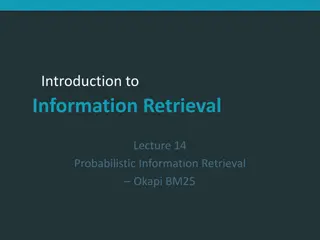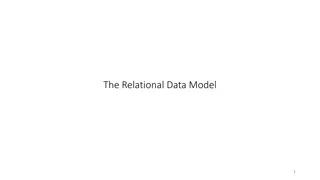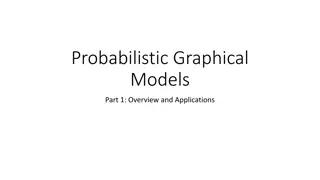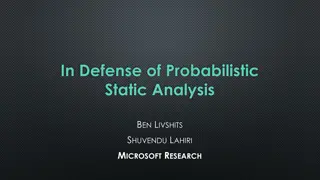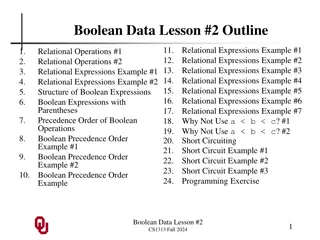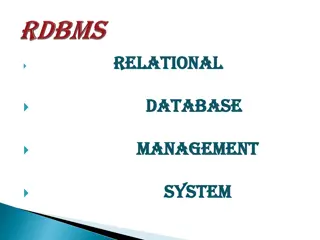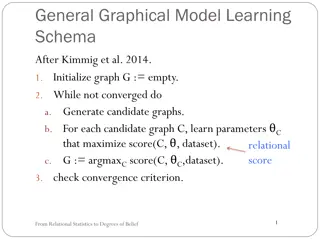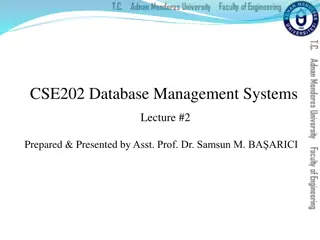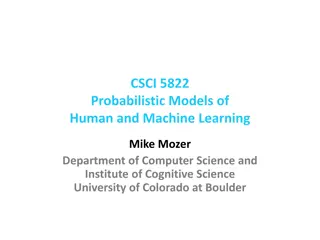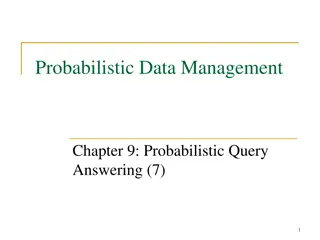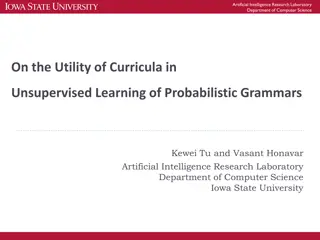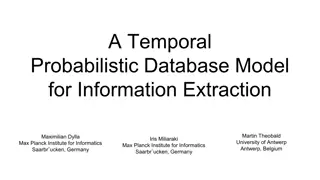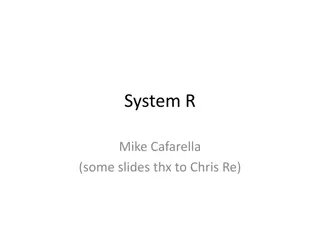
Scalable Statistical Relational Learning Challenges
Explore the challenges of noise, incompleteness, ambiguity, and complex queries like identifying Canadian hockey teams that won the Stanley Cup. Learn about acquiring domain models and using them efficiently in probabilistic reasoning. Discover how Scalable Statistical Relational Learning addresses these issues.
Download Presentation

Please find below an Image/Link to download the presentation.
The content on the website is provided AS IS for your information and personal use only. It may not be sold, licensed, or shared on other websites without obtaining consent from the author. If you encounter any issues during the download, it is possible that the publisher has removed the file from their server.
You are allowed to download the files provided on this website for personal or commercial use, subject to the condition that they are used lawfully. All files are the property of their respective owners.
The content on the website is provided AS IS for your information and personal use only. It may not be sold, licensed, or shared on other websites without obtaining consent from the author.
E N D
Presentation Transcript
Challenges: Robustness: noise, incompleteness, ambiguity ( Sunnybrook ), statistical information ( foundInRoom(bathtub, bathroom) ), Complex queries: which Canadian hockey teams have won the Stanley Cup? Extensions to annotations required (exploit domain knowledge) Learning: how to acquire and maintain domain models as well as how to use it Expressive, probabilistic, efficient: pick any two Wang&Cohen, Scalable Statistical Relational Learning for NLP
Three Areas of Data Science Probabilistic logics, Representation learning Abstract Machines, Binarization Scalable Probabilistic Relational Reasoning & Learning Scalable Learning 3 Wang&Cohen, Scalable Statistical Relational Learning for NLP
A program defines a unique least Herbrand model Example program: grandparent(X,Y):-parent(X,Z),parent(Z,Y). parent(alice,bob). parent(bob,chip). parent(bob,dana). The least Herbrand model also includes grandparent(alice,dana) and grandparent(alice,chip). Finding the least Herbrand model: theorem proving Usually we care about answering queries: What are values of W: grandparent(alice,W) ? H/T: Probabilistic Logic Programming, De Raedt and Kersting
[h/t Pedro Domingos] Smoking Cancer (S,C) False False 4.5 P(x)=1 c Fc(xc) False True 4.5 Z True False 2.7 =1 i True True 4.5 Fc(xc) Zexp A soft constraint that smoking cancer
[Domingos et al] QA w.r.t. is a set of hard constraints on the set of possible worlds constrained to be deductively closed Let's make closure a soft constraint: When a world is not deductively closed, it becomes less probable Give each rule a weight which is a reward for satisfying it: (Higher weight ( weights exp P(world) Stronger constraint) ) of formulas it satisfies Wang&Cohen, Scalable Statistical Relational Learning for NLP
A Markov Logic Network (MLN) is a set of pairs (F, w) where F is a formula in first-order logic w is a real number Together with a set of constants, it defines a Markov network with One node for each grounding of each predicate in the MLN each element of the Herbrand base One feature for each grounding of each formula F in the MLN, with the corresponding weight w
Smoking causes cancer. Friends have similar smoking habits.
( ) ( ) x Smokes x Cancer x ( ) ) y , ( , ) ( ) ( x y Friends x y Smokes x Smokes
5 . 1 ( ) ( ) x Smokes x Cancer x ( ) ) y 1 . 1 , ( , ) ( ) ( x y Friends x y Smokes x Smokes
5 . 1 ( ) ( ) x Smokes x Cancer x ( ) ) y 1 . 1 , ( , ) ( ) ( x y Friends x y Smokes x Smokes
5 . 1 ( ) ( ) x Smokes x Cancer x ( ) ) y 1 . 1 , ( , ) ( ) ( x y Friends x y Smokes x Smokes
5 . 1 ( ) ( ) x Smokes x Cancer x ( ) ) y 1 . 1 , ( , ) ( ) ( x y Friends x y Smokes x Smokes
5 . 1 ( ) ( ) x Smokes x Cancer x ( ) ) y 1 . 1 , ( , ) ( ) ( x y Friends x y Smokes x Smokes
5 . 1 ( ) ( ) x Smokes x Cancer x ( ) ) y 1 . 1 , ( , ) ( ) ( x y Friends x y Smokes x Smokes
P(x)=1 i Zexp wini(x) P(x)=1 c Fc(xc) Recall for ordinary Markov net Z =1 i Fc(xc) Zexp
Subsets of Herbrand base ~ domain of joint distribution Interpretation ~ element of the joint Consistency with all clauses A:-B1, ,Bk , i.e. model of program ~ compatibility with program as determined by clique potentials Reaches logic in the limit when potentials are infinite (sort of)
Inference done by explicitly building a ground MLN Herbrand base is huge for reasonable programs: It grows faster than the size of the DB of facts You d like to able to use a huge DB NELL is O(10M) After that, inference on an arbitrary MLN is expensive: #P-complete It s not obvious how to restrict the template so the MLNs will be tractable Wang&Cohen, Scalable Statistical Relational Learning for NLP
r3. status(X,tired) :- child(W,X), infant(W), weighted(r3). r3. status(X,T) :- child(W,X), infant(W), assign_tired(T), weighted(r3). assign_tired(tired),1 weighted(r3),0.88 Wang&Cohen, Scalable Statistical Relational Learning for NLP
[ [ [ [ ] ( ) ( ( ( ( ) ) ) ) ( ( ( ( z ) ) ] ) ] ) ] $ , , , Grandparen t x y Mother x z Mother z y z $ , , Mother x z Father z y z $ , , Father x z Mother z y z $ , , Father x z Father y z
[ ] ( ) ( ) ( ) , , , Parent x y Mother x y Father x y
Parent(Elizabeth, y) Grandparent(George, y) True Parent(Elizabeth, Anne) [y/Anne] True Grandparent(George, Anne) Grandparent(George, Anne) False True False
Father(George,y) P(x,y) P(George,y) Ancestor(George,y) [x/George] Father(George,y) Ancestor(George,y)






